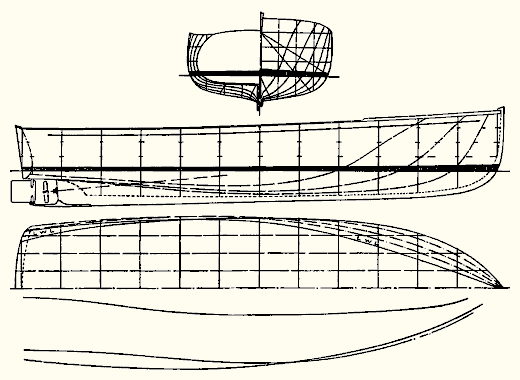
| Navarana A 37' Trunk-Cabin Cruiser By William & John Atkin |
| A Fast Trunk-Cabin Cruiser | |
| And if you ask me whence comes the name, Navarana, let me suggest a reading of Arctic Adventure by Peter Freuchen. So genuine and good was Navarana, Eskimo wife of Peter Freuchen, that so long as the history of Northern Greenland lives the name of this brave little woman will endure. But here is not the place for book review; perhaps it will be enough for me to suggest your adding it to the book shelf in the cabin. And so let's hope the 37-foot cruiser represented by the plans here will be pronounced as good. Many hours have gone into the making of this design, and I am sure that once built, she will be something apart from the usual conception of a wholesome and moderately fast motor boat; I like to think good enough to be named Navarana. Exactly 37 feet over all measures her length; and this is unusual because with few exceptions most of my fleet come out at a various number of feet, and inches. A good omen, maybe. Her waterline length is 36 feet 0 inches; breadth 10 feet 10 inches and her draft 2 feet 9 1/2 inches. The freeboard at the bow is 4 feet 6 inches; at the stern 3 feet 2 3/4 inches. | |

| |
| The deck arrangement shows a cockpit 10 feet 8 inches long and 8 feet wide. The standing top and windshield covers somewhat over half of this which leaves room aft in which to gather sunlight, or to swing fish poles. Under the after deck there is a handy stowage space for gear and if desired for a metal-lined fish box. There will be a perfectly amazing amount of room under the after deck and stern seat. The motor, of course, is beneath the flush hatches; and the fuel tanks are also below the cockpit floor. The ice box is built in one corner of the cockpit; it fills from outside; but has proper doors in the galley for handiness. The cabin house is 15 feet 4 inches long. In profile the fore end sweeps down into the deck giving the effect of great length and little height; also the fore end pinches together to avoid the heavy appearance of the usual wide bow end. To add to the length the cabin sides extend well ahead of the house itself, not unlike the usual practice with coamings. With the unusually wide side decks and the toe rail, or cleating, extending the entire length of the sheer getting forward is not a difficult undertaking. | |

| |
| The interior accommodations show large units of space. The galley, for instance, is 5 feet 9 inches long and extends the full width of the boat, very nearly 6 feet from the face of the stove to the face of the hanging lockers and chest of drawers on the opposite side. A coal range, dish closets, sink, wash tray, and lockers find ample room in the galley. And with its 6 feet 2 inches of headroom there is room to spare. The main cabin is fitted with two built in berths having drawers under and regulation pullman pipe berths that form seat backs. Lockers for blankets, sheets, etc., are provided behind the pipe berths. There is a space of 32 inches between the berth fronts. The toilet room adjoins the main cabin and is fitted out in the approved manner. It is 3 feet 4 inches long by the width of the boat. Fixed wash basin, lockers, W. C., and so on bring this up to date. The water tank is in the bow supplying by gravity. | |

| |
The hull shows a round bilge model having wide flat floors and easy bilges. There is generous flare and flam in the forward sections and rather more tumble-home at the stern than current practice shows. The tumble-home aft permits ample breadth at the water line and below, and at the same time allows the deck lines to pinch in thus getting away from the straightsidedness of the usual broad-sterned cruiser. It will be noticed that the rabbet line and the three buttock lines all show a distinct reverse curve abaft station 8. This feature if not over-done results in a very smooth wake and effectively keeps the stern from settling badly. From station 11 to the stern the rabbet and buttock lines become nearly parallel to the water line; here then is a built-in squat board. After my usual practice the sections abaft station 6 show a reverse turn. The purpose of this is to add strength to the deadwood and to provide depth inside for the better accommodation of the power plant. Even with the big Kermath motor shown the shaft angle is unusually small, 12 degrees. And the less the shaft angle the more efficient the propeller will, be. The motor shown is a 150 h.p. Kermath Seafarer and with this Navarana will have a top speed of 18 miles an hour. There are other highly suitable motors that just fit this design; ask the advice of your local motor dealer. Others that come to mind are: Red Wing, Universal, Chrysler, Buda, Gray, Scripps and Hall Scott. Do not power this design for top speeds of less than 13 miles an hour. The model is too flat fore and aft for efficient low speeds. | |
| Plans for Navarana are $100 MYSTIC SEAPORT MUSEUM SHIPS PLANS STORE https://store.mysticseaport.org/ships-plans/ shipsplanstore@mysticseaport.org
+1 (860) 572 5360 | |
| BACK TO PLAN LIST | |